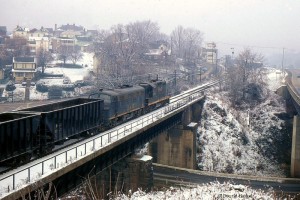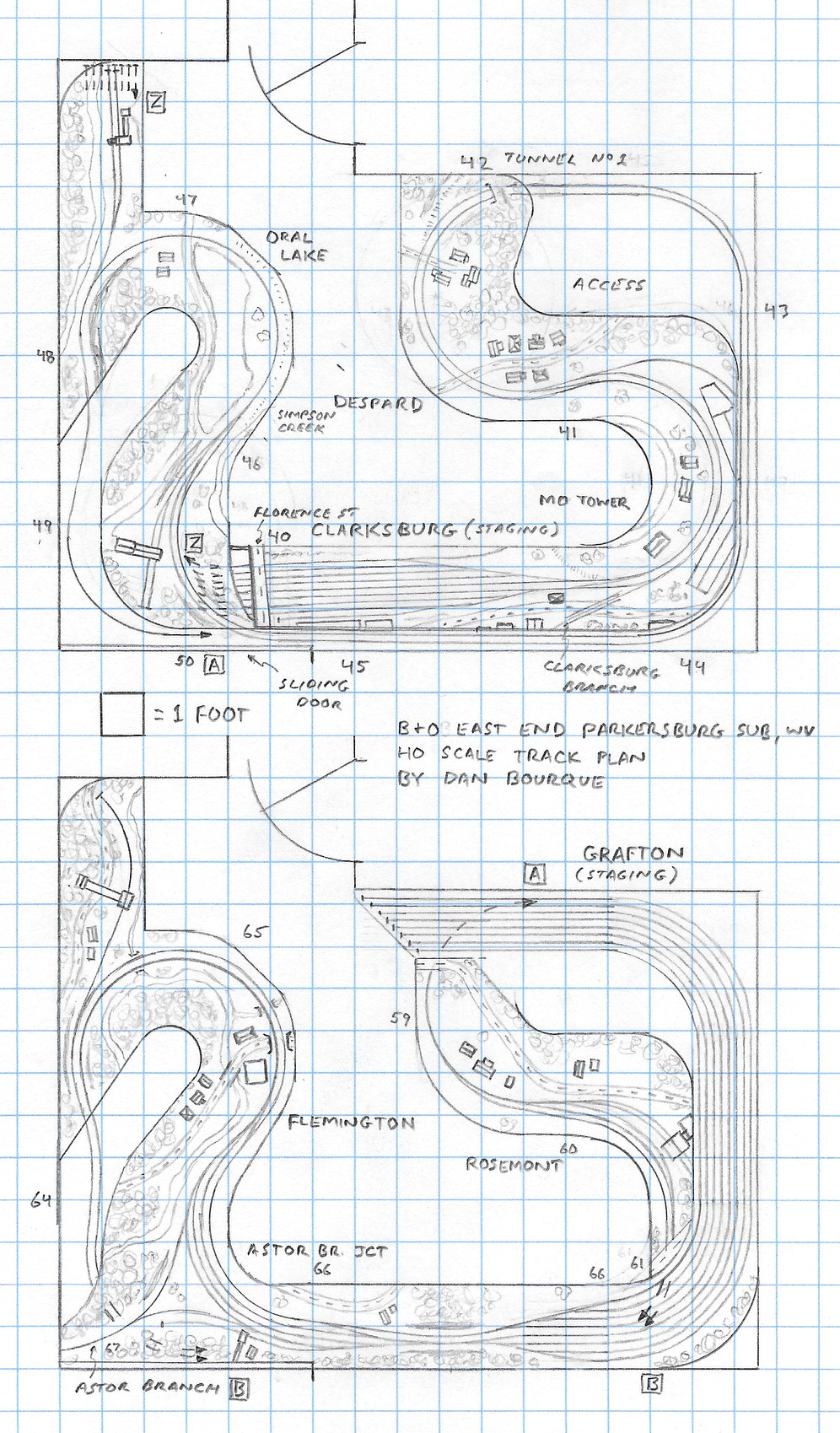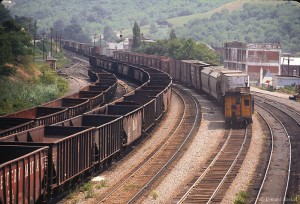- Size: 14′ x 17′
- Scale: HO
- Minimum Radius: 28″
- Minimum Aisle Width: 30″
- Designed by Dan Bourque
 The B&O’s Parkersburg Sub of the Monongah Division, known as “the Branch,” was a critical part of the B&O’s mainline from Maryland to St. Louis. Despite traveling through coal country, this line was more important as a thoroughfare for fast freights and passenger trains. Still, the yard at Clarksburg, WV was a key base for not only industry but mine runs which ran in every direction on branches and lines north, south and east including many smaller tipples along the mainline between Clarksburg and Grafton, WV making this a great subject for the modeler.
The B&O’s Parkersburg Sub of the Monongah Division, known as “the Branch,” was a critical part of the B&O’s mainline from Maryland to St. Louis. Despite traveling through coal country, this line was more important as a thoroughfare for fast freights and passenger trains. Still, the yard at Clarksburg, WV was a key base for not only industry but mine runs which ran in every direction on branches and lines north, south and east including many smaller tipples along the mainline between Clarksburg and Grafton, WV making this a great subject for the modeler.
The Layout
This track plan represents the portion of the Parkersburg Sub between Clarksburg and Grafton circa the 1960s when passenger trains still ran these rails, coal was still plentiful, and TOFC trains were becoming popular. It’s designed to feature the mainline trains with coal operations as the supporting cast. One of the constraints of this layout was “no helix,” but the large scope and limited space demanded a double-deck design, so I opted for an around-the-walls approach to climbing which leaves about 18″ between decks even with a modest 2-percent grade behind the scenes. You could make more space between decks with a steeper grade, but I like 2-percent to ensure more reliable running on hidden tracks.
The layout is designed as a series of four vignettes with running space between them to increase the distance of the mainline run. The first vignette at the lowest level is Clarksburg, WV. There were two yards at Clarksburg, so to save space, I’ve chosen to model only the eastern half of the eastern yard which is conveniently traversed by the Florence Street Bridge making a transition through the backdrop easy. Because there’s not a lot of classification work needed to run this layout, the yard actually serves as visible staging for the west end of the line with tracks ranging from 17-20′ long (4-6′ visible)–this means passenger and other distinctive trains can be hidden in the non-visible portion to avoid making the yard look odd. Also in this section are a handful of industries and the west portal of Tunnel No 1, the only tunnel on this portion of the line.
From Tunnel No 1, the double-track main climbs along the wall behind Clarksburg to reach Oral Lake. I skipped the town of Bridgeport which is sizeable but not too exciting from a railroad operations perspective. Instead, I chose to include two small tipples that flanked the small lake at Oral Lake. I also had to move the east end of double track a couple miles from Bridgeport to Oral Lake so both ends could be easily seen and operated. From Oral Lake, the single-track main climbs the wall behind Clarksburg again to reach the second level at Rosemont, home of a siding and a tipple. While roads crossed this portion of the line, the bridges concealing the transition through the backdrop are contrived–a compromise, but not out-of-character with this area.
The mainline runs under the scenery for a bit to reach nearby Flemington, home to a small yard that served the coal-rich Astor Branch. The version of the yard in this layout is definitely condensed, but it’s enough to stage hoppers to/from the branch and to do a little coal classification. I’ve also included a small tipple that lived at the east end of Rosemont along the wall, and I’ve brought another small tipple a mile or so to the west alongside the yard at Flemington for extra operation. From Flemington, the double-track main goes through a cut to another partially visible staging yard, this one representing the division point yard at Grafton, WV–these tracks are slightly shorter than Clarksburg (14-20′ long) but still offer plenty of room for long trains.
Powering this layout would be simple with a medium to advanced DCC system, and with all the trains and track, multiple boosters would help avoid shut-downs on the entire layout due to a single problem. Construction of this layout offers some challenges. First, the benchwork needs to be at multiple heights to maintain enough space between levels. Second, there’s a lot of hidden mainline that creates access issues. I’ve included a couple of narrow access areas in the turn-backs at the ends of the layout for this purpose. Also, there’s a sliding glass door in the lower left corner–it doesn’t need to be accessed routinely, but it offers a great emergency access point. Even with these access points, there is still about 16′ of mainline x2 hidden behind Clarksburg. For this, I recommend making the backdrop in easily removable sections to prevent major headache when things go wrong.
Operations
This layout would easily occupy 3-5 operators for a few hours. Each session would need a local crew and a few mainline crews, and any more than 1-2 mainline crews would necessitate a dispatcher to keep the trains separated and make good use of the pair of long sidings to keep things running briskly. There were several daily trains on the Parkersburg Sub timetable including fast/TOFC freights and passenger trains, and a lot of coal moved from Clarksburg east to Grafton in extras (with reciprocating empties from the other direction). There is enough staging to run 15-16 trains if desired with coal drags trudging from siding to siding behind strings of F7s and early geeps and staying out of the way of faster freights led by second-generation diesels like GP30s and SD35s hauling long trains of TOFC flats and boxcars.
The local mine run would start out in Clarksburg with a pair of F-units or GPs and a long string of empties to work the tipples between Oral Lake and Flemington. The mine run might first work the handful of industries at Clarksburg before heading up the road, dropping empties on the way up, pulling eastbound loads and leaving westbound loads. Coal ran both ways on this line, but mostly east. At Flemington, the mine run would do some light classification of the loads waiting in the yard (simulating mine runs off the Astor Branch) to separate eastbound and westbound loads and leaving some empties for later mine runs. With westbound loads in tow, the mine run would return to Clarksburg, picking up any remaining westbound loads from the tipples along the way.
The scenery in this area didn’t change much between the 1940s and 1980s, so it would be easy to run sessions in different eras. Earlier sessions might blend steam and diesel power, TOFC would still be a future idea, and passenger trains would be longer and more plentiful. A later session might feature a short Amtrak train instead of B&O, more fast freight, and fewer active tipples.
Things I Like About this Plan:
- Great blend of coal, fast freight and passenger trains
- Long mainline run for the space
- Generous aisle space
- Visible staging
Things I Don’t Like About this Plan:
- Tight radius for passenger cars and TOFC flats–recommend 2.5″ spacing on double-track curves
- Hidden track with no easy access
- No continuous running
Related Products:






